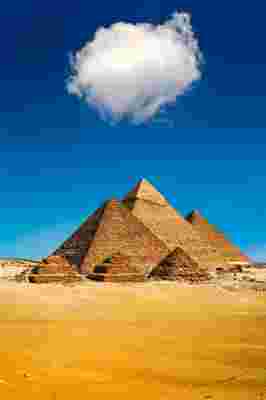Facts You Never Knew About the Pyramids of Giza
It’s no wonder that our fascination with the pyramids of Giza have endured for millennia. The massive Great Pyramid—built for the Pharaoh Khufu and finished around 2560 B.C.E.—is the only marvel of the original Seven Wonders of the Ancient World still intact. And the rest of the complex is nothing short of brilliant, too. Perched on the outskirts of Cairo, the Giza site contains six pyramids in total: three towering ones, including the Great Pyramid, and three smaller ones—plus an enormous statue of a sphinx, for good measure.
You’d think that a few thousand years on Earth would have revealed all of the pyramids’ mysteries by now, but it seems they still have plenty of secrets to share. As recently as last fall, new chambers were discovered in the Great Pyramid . And like any ancient sites worth their sand and stone, they’ve inspired passionate debates—not to mention a few conspiracy theories—over the years, too. Below are a few more facts you might not have known about these formidable structures:

The pyramids from the Giza Plateau.
A Feast Fit for Kings :
Today, after centuries of erosion, the Great Pyramid of Giza stands about 450 feet high. (To put that in context, the Statue of Liberty tops out at 305 feet.) For nearly 4,000 years, it was the tallest building in the world—and it’s hefty, too. The pyramid was built with an estimated 2.3 million stone blocks, which weigh 2.5 to 15 tons each .
Clearly, constructing the pyramids required massive manpower. For a long time they were believed to have been built by slaves. But research from the past few decades suggests otherwise. In the village surrounding the pyramids, archaeologists discovered remains from enough sheep, cows, and goat for thousands of people to eat meat every day—meaning, says Harvard Magazine , “that the pyramid workers were fed by royalty… [and] they were not slaves at all, at least not in the modern sense.”
Shine Bright Like a Diamond :
Today, the Giza pyramids wear the tawny tones of their surrounding Libyan Desert. But back in their heyday, they sparkled. Originally, the pyramids were encased in slabs of highly polished white limestone. When the sun struck them, they lit up and shimmered. Some researchers believe that the pyramids’ capstones were plated in gold as well.
Those dazzling façades have long been stripped—some sources report that those blocks of stone were repurposed and used to build mosques—but you can still see remnants of a once-snowy cap atop the middle pyramid. (And you can see The Smithsonian’s rendering of what the pyramids looked like in their glory years.)
Written in the Stars?
If you ever find yourself out for drinks with some Ancient Egypt buffs, try to keep the conversation terrestrial. There’s an ongoing debate among Egyptologists about whether (and how) the pyramids were built to align with the cosmos—and things get heated quickly.
In his 1995 book The Orion Mystery , Ancient Egypt buff Robert Bauval posited that the three largest pyramids in the Giza complex were built to correspond with the three stars in Orion’s Belt as they appeared at the time the pyramids were built. Scientists leapt to contest this, pointing out that the pyramids—or the stars—would have to have been flipped upside-down for the theory to track.
Five years later University of Cambridge professor Kate Spence pitched a similar hypothesis—and it, too, was met with a critical eye. For a long time, scientists have struggled to explain how the ancient Egyptians managed to align the pyramids so precisely north when, at the time, there was no North Star to guide them (meaning, a star situated directly above the North Pole). In her 2000 paper, Spence suggested that Ancient Egyptians instead pegged the pyramid to the two stars circling the North Pole at the time. Hawkeyed colleagues were quick to note that while her theory seemed sound, her math was off and she’d named the wrong pair of celestial bodies. This debate, it seems, is one that won't be ending anytime soon.